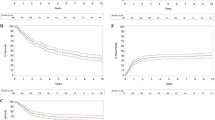Abstract
The increasing use of primary chemoradiation (CRT) for laryngeal squamous cell carcinoma (SCC) means that historical surgical data sets are not representative of the modern laryngectomy patient. We analyse a contemporary total laryngectomy (TL) cohort to identify factors predictive of outcome. This is a retrospective consecutive case note review in a UK tertiary referral centre. Demographic, staging, treatment and outcome data were collected. Oncological outcomes are expressed using the Kaplan–Meier method. The log-rank test was used for univariate analysis and cox regression for multivariate analysis. Sixty consecutive patients between 2003 and 2010 underwent primary TL, 28 including partial pharyngectomy. Median age was 61 years and mean follow-up was 24 months (1–78 months). Thirty six patients died during the study period, 24 of their disease. Of the disease-specific deaths, two occurred peri-operatively, four from local, two from regional and 18 from distant disease [two patients had simultaneous local and distant recurrence (DR)]. Five-year overall survival, disease-specific survival, loco-regional recurrence-free survival and distant recurrence-free survival (DRFS) were 36, 51, 87, 62 %, respectively. Of 17 parameters analysed, pN-stage, extra-capsular spread, a non-cohesive tumour front, thyroid infiltration and involvement of level 6 were significant predictors of disease-specific survival (DSS) on univariate analysis. pN > 1 and the presence of adverse histological features were found to be independent predictors of DSS and DRFS on multivariate analysis. Neither was significantly associated with loco-regional recurrence-free survival. Around half of patients who undergo TL for stage IV SCC will die of disease within 5 years, with most deaths attributable to DR. Surgery provides excellent loco-regional control but patients, especially those with advanced nodal disease and/or adverse histological features, should be thoroughly screened for occult distant disease.
Level of evidence 4.

Similar content being viewed by others
References
Jemal A, Siegel R, Ward E, Hao Y, Xu J, Thun MJ (2009) Cancer statistics, 2009. CA Cancer J Clin 59(4):225–249. doi:10.3322/caac.20006
Shah JP, Karnell LH, Hoffman HT, Ariyan S, Brown GS, Fee WE, Glass AG, Goepfert H, Ossoff RH, Fremgen A (1997) Patterns of care for cancer of the larynx in the United States. Arch Otolaryngol Head Neck Surg 123(5):475–483
Hoffman HT, Porter K, Karnell LH, Cooper JS, Weber RS, Langer CJ, Ang KK, Gay G, Stewart A, Robinson RA (2006) Laryngeal cancer in the United States: changes in demographics, patterns of care, and survival. Laryngoscope 116(9 Pt 2 Suppl 111):1–13. doi:10.1097/01.mlg.0000236095.97947.26
Olsen KD (2010) Reexamining the treatment of advanced laryngeal cancer. Head Neck 32(1):1–7. doi:10.1002/hed.21294
Wolf GT (2010) Reexamining the treatment of advanced laryngeal cancer: the VA laryngeal cancer study revisited. Head Neck 32(1):7–14. doi:10.1002/hed.21296
Forastiere AA (2010) Larynx preservation and survival trends: should there be concern? Head Neck 32(1):14–17. doi:10.1002/hed.21295
Induction chemotherapy plus radiation compared with surgery plus radiation in patients with advanced laryngeal cancer. The Department of Veterans Affairs Laryngeal Cancer Study Group (1991). N Engl J Med 324(24):1685–1690. doi:10.1056/NEJM199106133242402
Forastiere AA, Goepfert H, Maor M, Pajak TF, Weber R, Morrison W, Glisson B, Trotti A, Ridge JA, Chao C, Peters G, Lee DJ, Leaf A, Ensley J, Cooper J (2003) Concurrent chemotherapy and radiotherapy for organ preservation in advanced laryngeal cancer. N Engl J Med 349(22):2091–2098. doi:10.1056/NEJMoa031317
Ferlito A, Shaha AR, Lefebvre JL, Silver CE, Rinaldo A (2002) Organ and voice preservation in advanced laryngeal cancer. Acta Otolaryngol 122(4):438–442
Dworkin JP, Hill SL, Stachler RJ, Meleca RJ, Kewson D (2006) Swallowing function outcomes following nonsurgical therapy for advanced-stage laryngeal carcinoma. Dysphagia 21(1):66–74. doi:10.1007/s00455-005-9001-8
Ganly I, Patel SG, Matsuo J, Singh B, Kraus DH, Boyle J, Wong RJ, Lee N, Pfister DG, Shaha AR, Shah JP (2009) Predictors of outcome for advanced-stage supraglottic laryngeal cancer. Head Neck 31(11):1489–1495. doi:10.1002/hed.21113
Franchin G, Minatel E, Gobitti C, Talamini R, Vaccher E, Sartor G, Politi D, Trovo MG, Barzan L (2003) Radiotherapy for patients with early-stage glottic carcinoma: univariate and multivariate analyses in a group of consecutive, unselected patients. Cancer 98(4):765–772. doi:10.1002/cncr.11575
Spector JG, Sessions DG, Haughey BH, Chao KS, Simpson J, El Mofty S, Perez CA (2001) Delayed regional metastases, distant metastases, and second primary malignancies in squamous cell carcinomas of the larynx and hypopharynx. Laryngoscope 111(6):1079–1087. doi:10.1097/00005537-200106000-00028
Licitra L, Bernier J, Grandi C, Locati L, Merlano M, Gatta G, Lefebvre JL (2003) Cancer of the larynx. Crit Rev Oncol Hematol 47(1):65–80
Hinerman RW, Mendenhall WM, Amdur RJ, Stringer SP, Villaret DB, Robbins KT (2002) Carcinoma of the supraglottic larynx: treatment results with radiotherapy alone or with planned neck dissection. Head Neck 24(5):456–467. doi:10.1002/hed.10069
Matsuo JM, Patel SG, Singh B, Wong RJ, Boyle JO, Kraus DH, Shaha AR, Zelefsky MJ, Pfister DG, Shah JP (2003) Clinical nodal stage is an independently significant predictor of distant failure in patients with squamous cell carcinoma of the larynx. Annals Surg 238(3):412–421. doi:10.1097/01.sla.0000086660.35809.8a; (discussion 421–412)
de Juan J, Garcia J, Lopez M, Orus C, Esteller E, Quer M, Leon X (2013) Inclusion of extracapsular spread in the pTNM classification system: a proposal for patients with head and neck carcinoma. JAMA Otolaryngol Head Neck Surg 139(5):483–488. doi:10.1001/jamaoto.2013.2666
Conflict of interest
None.
Author information
Authors and Affiliations
Corresponding author
Rights and permissions
About this article
Cite this article
Pezier, T.F., Nixon, I.J., Joshi, A. et al. Factors predictive of outcome following primary total laryngectomy for advanced squamous cell carcinoma. Eur Arch Otorhinolaryngol 271, 2503–2509 (2014). https://doi.org/10.1007/s00405-013-2779-3
Received:
Accepted:
Published:
Issue Date:
DOI: https://doi.org/10.1007/s00405-013-2779-3




